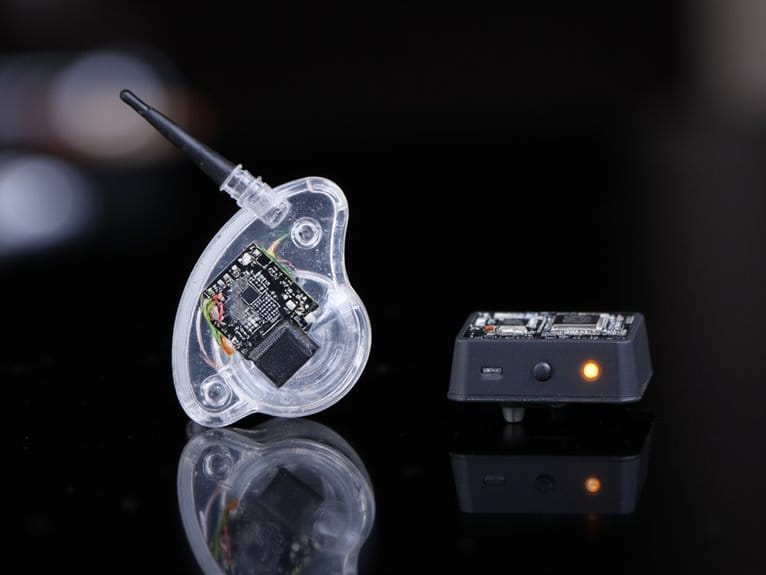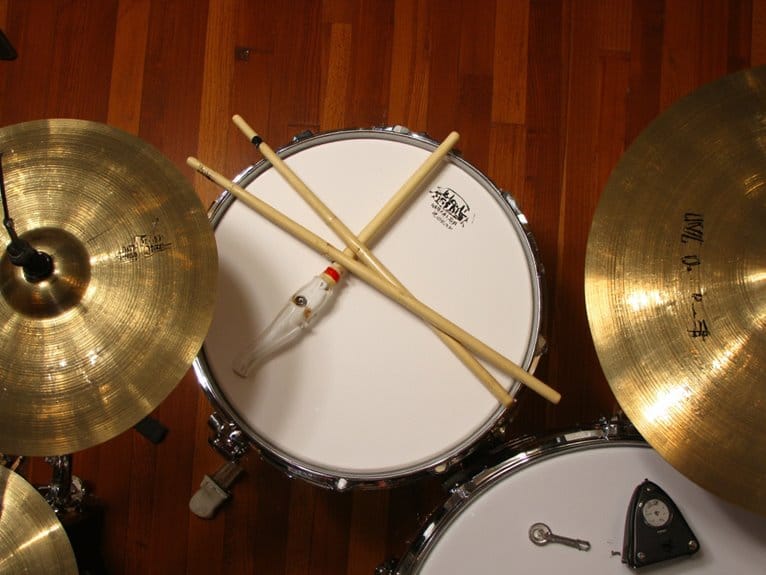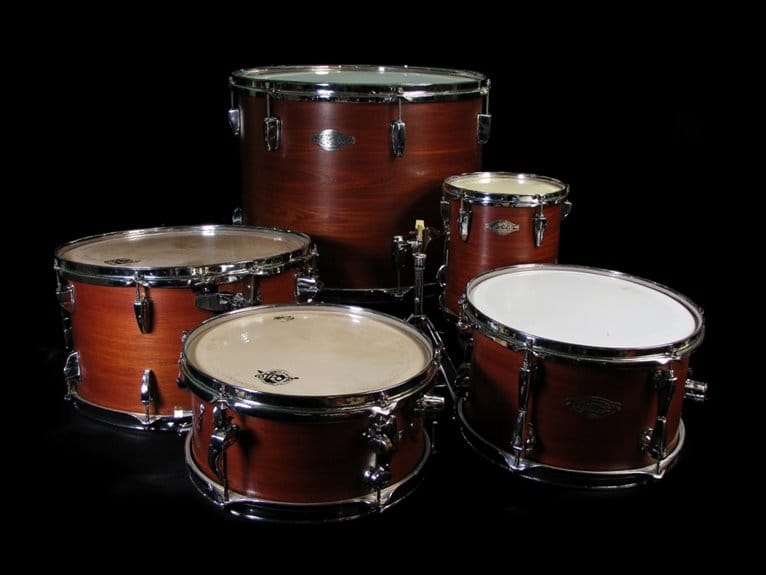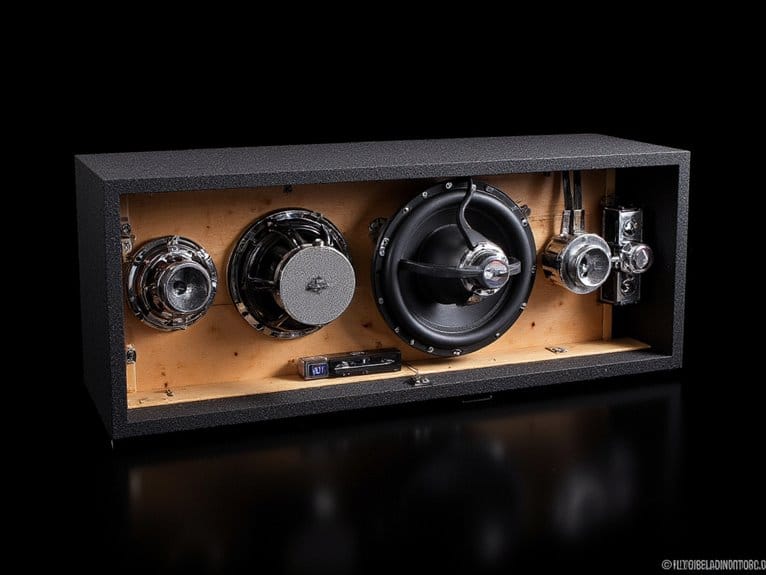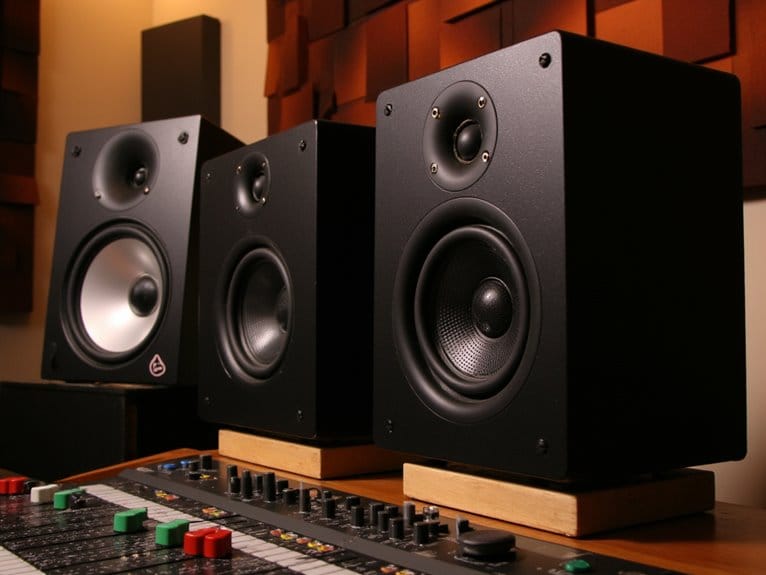Wireless In-Ear Monitor Systems: How They Work
When you’re performing live, wireless in-ear monitor systems work by converting your audio mix into radio frequency signals at a transmitter, which broadcasts to a compact receiver you wear on your belt or body. The receiver captures these RF signals, converts them back to audio, and delivers crystal-clear sound through earphones that fit directly in your ear canal, providing superior sound isolation and mix clarity compared to traditional stage monitors. Understanding the technical specifications and setup options reveals how these systems can transform your performance experience.
We are supported by our audience. When you purchase through links on our site, we may earn an affiliate commission, at no extra cost for you. Learn more.
Notable Insights
- Wireless IEM systems convert audio signals to RF transmission at the transmitter, then back to audio at the receiver for direct ear canal delivery.
- Systems use UHF or 2.4GHz frequency bands with digital modulation technologies like QAM and PSK for reliable, low-latency signal transmission.
- Professional systems achieve sub-5ms latency, 24-bit/48kHz sampling rates, and signal-to-noise ratios exceeding 100dB for high-fidelity monitoring.
- Effective frequency coordination prevents interference by spacing IEM channels 15MHz apart and separating them from wireless microphones within available bands.
- RF signals are captured by body-pack receivers, converted to analog audio, and delivered through earphones that provide sound isolation and mix clarity.
Core Components and Audio Signal Path
When you’re standing on stage and need to hear your monitor mix with crystal clarity, a wireless in-ear monitor system becomes your lifeline to professional performance.
I’ve found that understanding its core components can make the difference between a flawless show and technical disaster. The transmitter converts your audio signals into RF transmission, while the receiver, clipped to your belt, captures and converts those signals back to high-quality audio.
Your earphones deliver this sound directly into your ear canal, and modern IEM design innovations have dramatically improved comfort and durability. The superior sound isolation these systems provide eliminates stage noise bleed, ensuring you hear every nuance of your mix without external interference disrupting your performance focus. Many systems utilize 2.4GHz transmission technology to deliver reliable performance with minimal latency during live performances. Advanced systems incorporate automatic frequency scanning to continuously optimize performance and minimize interference from other electronic devices. Professional wireless systems offer full stage mobility without the constraints and trip hazards of traditional cable connections. Modern wireless IEM systems typically provide an impressive 300-foot range that accommodates most performance venues while maintaining signal integrity.
Radio Frequency Transmission and Modulation Technology
When you’re selecting a wireless IEM system, you’ll encounter different modulation technologies that directly impact how your audio signal travels from the transmitter to your ears, with FM stereo modulation remaining popular for its reliability, though digital alternatives now offer superior performance metrics.
Your system’s frequency band management becomes essential since you’re operating in increasingly crowded RF environments where Wi-Fi networks, cell phones, and other wireless devices compete for the same spectrum space, requiring smart frequency coordination to avoid dropouts during critical moments.
I’ve learned that understanding signal quality metrics like signal-to-noise ratio, total harmonic distortion, and dynamic range helps you evaluate whether a particular system will deliver the pristine audio reproduction you need, especially when you’re investing significant money in professional-grade equipment.
Professional wireless IEM systems typically operate across different frequency bands, with UHF systems generally providing better stability and reliability compared to 2.4GHz alternatives, particularly in interference-heavy environments where multiple wireless devices are competing for spectrum space.
FM Stereo Modulation
Although many musicians take their wireless in-ear monitor systems for granted, I’ve found that understanding FM stereo modulation reveals why these systems deliver such reliable, high-quality audio during live performances.
When you’re using these systems, sophisticated fm signal processing separates your left and right audio channels using sum (L+R) and difference (L−R) techniques, which are then multiplexed onto the FM carrier wave.
The modulation techniques I’ve observed vary the carrier frequency proportional to your audio input amplitude, while a 19 kHz pilot tone helps your receiver accurately reconstruct stereo separation.
This process, combined with precise oscillator control and frequency multipliers, guarantees you’ll receive clear, interference-resistant audio with minimal latency compared to AM alternatives.
Frequency Band Management
Since wireless in-ear monitor systems rely on precise frequency coordination to deliver interference-free audio, I’ve learned that effective frequency band management becomes the foundation for any successful live performance setup.
You’ll need to master frequency allocation within UHF bands, where preconfigured frequency banks simplify coordination by grouping compatible channels together. I’ve discovered that checking channel occupancy before each performance prevents costly interference issues that could derail your show.
Your frequency coordination approach should include:
- Scanning channels at soundcheck – detecting RF and AF signals while unplugging earphones to avoid hearing unintended transmissions
- Selecting coordination profiles – choosing between Standard, Robust, or More Frequencies options based on your interference tolerance needs
- Monitoring backup frequencies – maintaining emergency replacements through automated spectrum management tools for seamless switching during critical moments
Signal Quality Metrics
Excellence in wireless IEM performance hinges on understanding the radio frequency transmission and modulation technologies that convert your audio into crystal-clear monitoring signals.
When I evaluate these systems, I focus on Total Harmonic Distortion (THD) and Intermodulation Distortion (IMD) as primary indicators of audio fidelity, since they reveal how faithfully your source material translates through the RF link. Digital modulation schemes like QAM and PSK greatly reduce signal degradation compared to older analog FM systems, maintaining superior clarity even in challenging RF environments.
You’ll want to prioritize systems offering 24-bit/48 kHz sampling rates with sub-6ms latency, as these specifications guarantee your monitoring remains both pristine and synchronized.
Signal-to-Noise Ratio measurements above 100 dB typically indicate professional-grade performance that’ll serve you reliably.
Frequency Management and Interference Prevention
When you’re managing multiple wireless IEM channels in today’s crowded RF environment, you’ll need systematic approaches to frequency coordination, interference detection, and signal optimization that go far beyond simply turning on your transmitters and hoping for the best.
I’ve learned through countless live productions that effective frequency management starts with automatic scanning protocols that identify clean channels before your performers take the stage, followed by strategic channel coordination that keeps your band’s frequencies properly spaced within compatible banks.
Your success depends on implementing proven RF interference solutions, including diversity reception, manual attenuation controls, and real-time frequency swapping capabilities that protect your audio quality when unexpected interference threatens your performance.
Automatic Frequency Scanning
The beauty of automatic frequency scanning lies in its ability to eliminate one of wireless IEM systems’ most persistent headaches-finding a clean frequency in today’s crowded RF landscape.
When you press that scan button, your system sweeps the entire RF spectrum, measuring signal strength and noise levels to identify the cleanest channels available. The frequency scanning benefits become immediately apparent as your system automatically selects ideal frequencies, preventing audio dropouts and interference conflicts that can ruin performances.
Here’s what happens during the scanning process:
- The built-in receiver module sweeps available frequencies, detecting interference from competing wireless devices.
- Signal strength measurements identify vacant channels with minimal RF noise contamination.
- Transmitter and receiver synchronize to the selected frequency for stable, interference-free communication.
These user friendly features transform complex frequency coordination into simple one-touch operation.
Channel Coordination Strategies
While automatic frequency scanning handles the heavy lifting of finding clean channels, successful wireless IEM deployment requires a deeper understanding of channel coordination strategies that’ll keep your entire RF ecosystem running smoothly.
Smart frequency allocation starts with grouping your wireless mics within narrow 5 MHz spans, then positioning IEM channels with 15 MHz spacing to create protective buffer zones.
I’ve found that operating mics and IEMs on opposite ends of your frequency band prevents signal overlap and those dreaded intermodulation products that can ruin a performance.
Stick exclusively to channels within the same frequency bank-mixing across different banks breaks the manufacturer’s carefully optimized compatibility matrix.
Before each show, manually scan your chosen channels even after automatic coordination, because RF environments change faster than you’d expect, and channel compatibility depends on real-time conditions.
RF Interference Solutions
RF interference lurks everywhere in today’s saturated spectrum environment, and I’ve learned that proactive interference management beats reactive troubleshooting every single time.
Modern interference solutions require thorough strategies that address both external noise sources and internal system weaknesses, which I’ve discovered through countless challenging installations.
Effective interference solutions include:
- Bandpass filtering implementation – Limiting frequencies outside your desired range while maintaining signal integrity through precise filter selection
- Strategic equipment placement – Positioning transmitters away from LED walls, lighting arrays, and other notorious RF noise generators that elevate your noise floor
- Adaptive frequency management – Employing automatic scanning protocols that dynamically shift channels when interference peaks, ensuring uninterrupted performance during critical moments
These techniques work synergistically, creating robust wireless systems that maintain clarity despite increasingly crowded spectrum conditions.
System Setup Options for Different Performance Scenarios
Several configuration approaches exist for wireless in-ear monitor systems, and I’ve found that choosing the right setup depends heavily on your band’s size, budget constraints, and performance requirements.
Basic single-transmitter systems work well for smaller groups, where you’ll share one monitor mix among all performers through multiple receivers tuned to the same frequency. While setup complexities remain minimal with this approach, it limits individual mix control.
For larger bands with diverse performance needs, multi-transmitter systems provide independent, customized mixes for each performer, though they require careful frequency coordination.
Digital mixer integration offers the most flexibility, allowing performers to control their own mixes via mobile apps, but demands more technical knowledge for proper network configuration.
Key Performance Advantages for Live Musicians
Nothing compares to the moment you first experience how wireless in-ear monitors transform your live performance, as they deliver a level of audio clarity and control that traditional stage monitors simply can’t match.
The musician experiences I’ve witnessed consistently demonstrate how these systems revolutionize stage dynamics, offering customized mixes that let you hear exactly what you need while eliminating feedback issues that plague conventional monitors.
The performance benefits extend beyond sound quality:
- Enhanced mobility – You’ll move freely across the stage without being tethered to monitor positions
- Reduced stage clutter – Your setup becomes streamlined, eliminating bulky monitor wedges and cables
- Superior hearing protection – Lower volume requirements preserve your hearing while delivering crystal-clear audio reproduction
These advantages collectively create more confident, controlled performances.
Current Limitations and Emerging Technological Developments
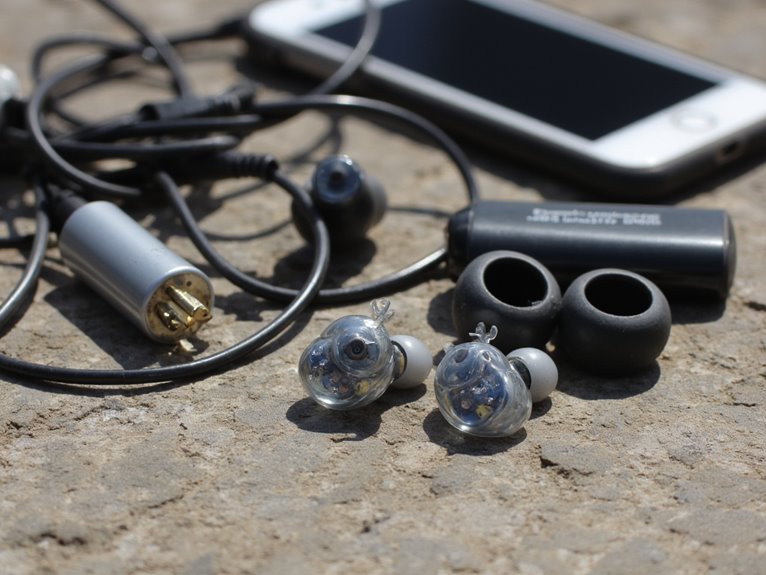
While wireless in-ear monitor technology has reached impressive heights in audio fidelity and reliability, I’ve observed that several persistent challenges continue to frustrate performers and audio engineers alike.
Signal degradation remains problematic when mixing manufacturers’ equipment, creating dead spots that can ruin performances, while frequency crowding in busy venues limits available channels and forces uncomfortable compromises.
Current pain points include:
Battery anxiety, earpiece fatigue, and RF interference storms plague wireless monitor systems, disrupting performances and creating constant technical stress for musicians.
- Battery anxiety – watching performers nervously check power levels mid-show
- Earpiece fatigue – witnessing musicians adjusting uncomfortable fits throughout concerts
- RF interference storms – experiencing static bursts from unexpected sources
Fortunately, emerging technologies address these issues through enhanced frequency agility offering 100+ channels per band, improved user comfort through advanced personal mix controls, and extended battery life via low-power chips and fast-charging capabilities.
Frequently Asked Questions
Can Wireless IEM Systems Work Outdoors in Different Weather Conditions?
You’ll find wireless IEM systems work well for outdoor performance, maintaining stable audio within 180 feet. They’re built with weather durability in mind, featuring metal transmitters and sturdy construction that resist rain, humidity, and temperature variations effectively.
How Do You Properly Clean and Maintain Wireless IEM Earphones?
You’ll maintain wireless IEMs through proper earphone hygiene using gentle cleaning techniques. Wipe exteriors with microfiber cloths, use alcohol wipes for wax removal, clean ear tips separately, and brush nozzles carefully without pushing debris inside.
On a final note
You’ve now got the foundation to understand how wireless in-ear systems transform your live performance experience, though admittedly, I’ve barely scratched the surface of RF complexities that’d make your head spin. When you’re ready to invest, you’ll find these systems offer freedom that wired monitoring simply can’t match, despite occasional dropouts that’ll remind you wireless isn’t perfect yet.

